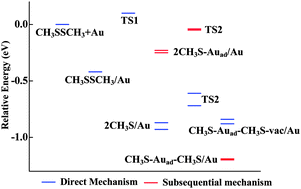By performing density functional theory calculations, we have examined the adsorption of dimethyl disulfide (CH3SSCH3) on Au(111). In addition, we have also charted the reaction paths leading to dissociation of the S–S bond and the formation of thiolate-adatom species. Further, we have simulated the scanning tunneling microscopic (STM) images of the key adsorption intermediates and products and compared them with the experimental data available in the literature. In summary, our computations show that CH3SSCH3 adsorbs on Au(111) non-dissociatively with a moderate adsorption energy 0.42 eV for the trans-conformation which is 0.24 eV more stable than its cis-isomer. When the adsorbed trans-CH3SSCH3 dissociates at low temperature, the two CH3S fragments are retained by the closest neighboring sites and the trans-conformation of them prior to S–S dissociation can be preserved. The activation barrier to rotating the CH3S fragments on Au(111) is 0.17 eV so a moderate temperature rise can facilitate the transformation of the trans-conformation and generate a mixture of the trans- and cis-conformation. Our calculations also show that intrinsic defects such as gold adatoms (Auad) are active in CH3SSCH3 dissociation in two mechanisms: a direct mechanism in which CH3SSCH3 dissociation drives Auad formation and CH3S–Auad formation simultaneously, with leftover vacancies as by-products; a sequential mechanism in which Auad is present in advance and subsequently interacts with a nearby CH3S fragment to form CH3S–Auad. The respective activation barriers are 0.15 and 0.32 eV for the trans- and cis-CH3S–Auad–SCH3 complex along the direct mechanism, and 0.21 and 0.18 eV along the sequential mechanism.
